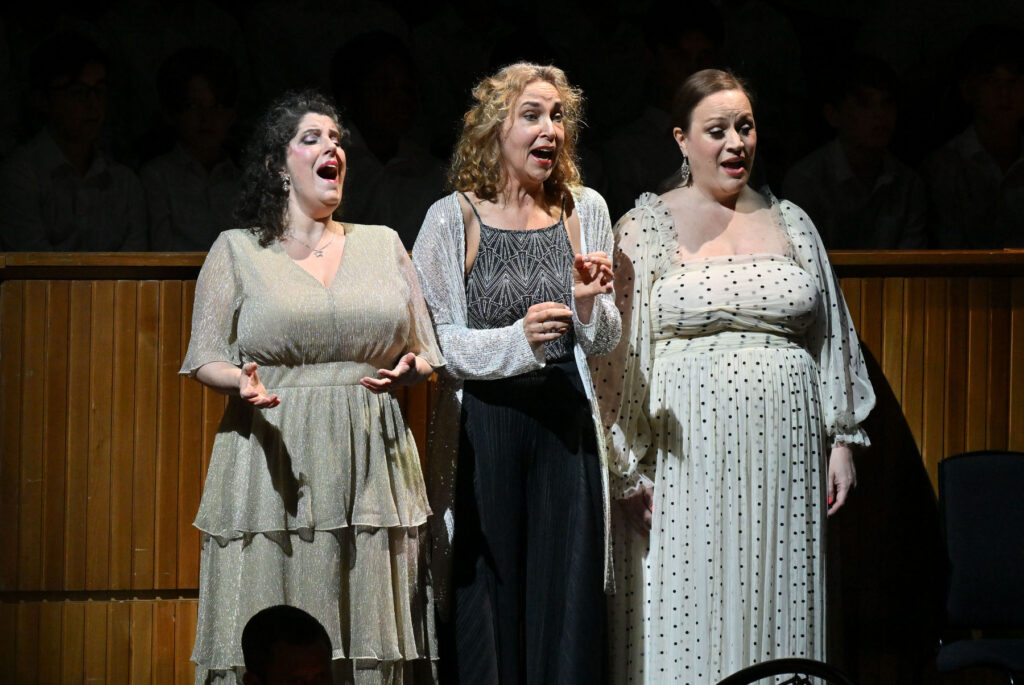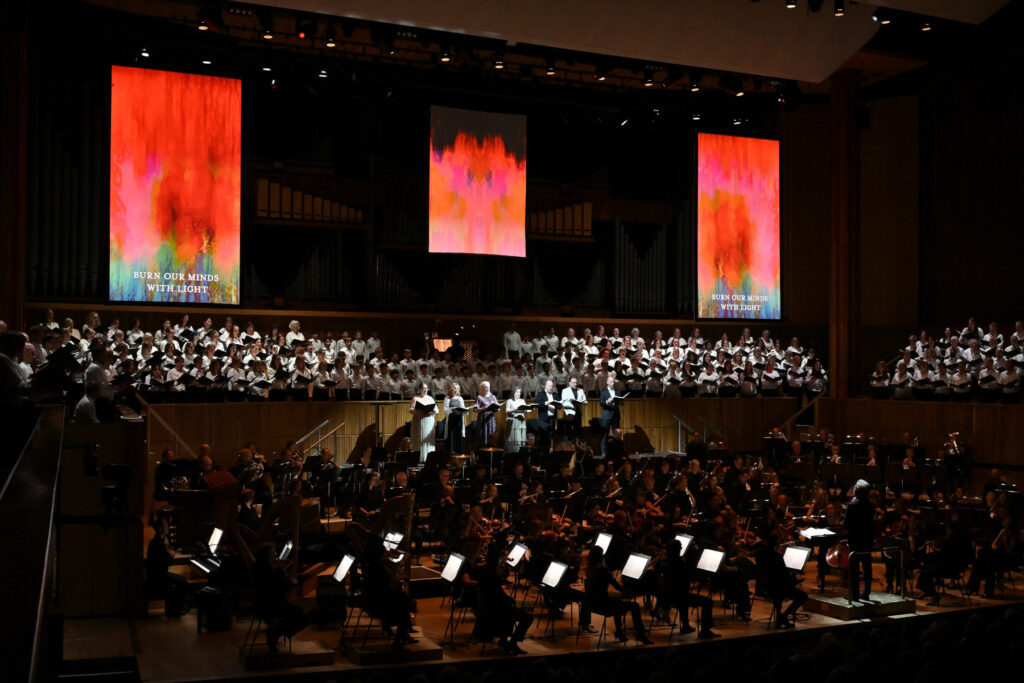Any Mahler Eighth Symphony is an occasion. It is an unwieldy, but nevertheless impressive behemoth of a piece. Interestingly enough, my most recent encounter with the symphony was also with the London Philharmonic Orchestra, back in 2017, conducted by Vladimir Jurowski and coupled with Thomas Tallis’ Spem in alium (and with an interval after the first movement!). It was, though, a terrific, blessedly video-free performance.
It seems Mahler 8 these days is not to be left alone. The Tallis was an interesting idea, and here we have a whole video experience, plus semi-staging. The theatre of the imagination is dead, long live the imposition of directorial sleights. Tom Morris was director, Tal Rosner the “video artist,” and Ben Ormerod was certainly kept busy as head of lighting design; Gillian Moore was in charge of musical dramaturgy.

This is not always a bad thing – witness Insula Orchestra’s most recent performances of Beethoven Wars, where König Stephan, Die Ruinen von Athen and Leonore Prohaska met Manga to deliver an environmental message for the planet. But what is one to do with one of the most elusive of all masterpieces (Goethe’s final part of Faust), not to mention the ninth-century Pentecostal hymn, sung in Latin, Veni, creator spiritus”: ‘Come, creating spirit’. Both texts focus on the redemptive power of love (or is that ‘Love’?); Goethe, however, puts a real emphasis firmly on the Divine Feminine (“Ewig-weibliche”), a counterbalance to the first part. While the first part is mighty, and dynamic pretty much throughout, the second builds slowly to an awe-inspiring hymn to Love.
Or it should. Wresting one’s attention from the projected images, one was presented with a performance that did not quite have the long view in mind, so the very close of the symphony lost some of its power. As to the videos themselves, it did rather feel as if someone had been let loose on a library of stock images: forests shown in negative, colour cascades, a green man (or a Green Man, a pagan reference?) and some that seemed culled from the sci-fi part of the image library. Lighting was adjusted according to scoring, too, so that when it was orchestra-only in the first movement, the choir was in relative darkness.

Gardner’s way was brisk, generating momentum and electricity for sure: he did have a crack orchestra at his command, after all, and a fine line-up of soloists. But the orchestra was less sure than under Jurowski (and I also think back, more recently, to Jurowski’s Lyatoshynsky, inspiring them to stunning heights). The combined choirs of the London Philharmonic and Symphony Orchestras, spilling out of the choir stalls into the audience space was terrific; as was the Tiffin Boys’ Choir, the best young choir I have heard in this piece, ever. The boys sang with real elan, even against Mahler’s gargantuan odds.
The soloists were all strong, and all known names; but the true achievement in Part I was how they worked together as a team.
There was atmosphere at the opening of Part II, and the antiphonal choral whispers of “Waldung, sie schwankt heran” (Forests sway) were phenomenally effective. Gardner’s approach to Mahler’s scoring here in, finally, an oasis of extended quiet, was remarkable, but most impressive was how he let Mahler’s almost skeletal writing speak for itself. In doing so, Gardner uncovered the piece’s modernity. Later, though, there was a loss of voltage, as if the end goal had been lost.
I did wonder if the images had a Manga reference in Part II; but elsewhere, echoes of Van Gogh seemed to be present. It was less that they enhanced Mahler, more offered challenges of interpretation that ultimately seemed unfulfilling in themselves.
Against all of this was the semi-staging of Part II. Strangest of all was Jennifer France’s silent gesturing from the Royal box, spotlit; when we did hear her sing (on stage this time) it was radiant. Faust, too, is present in video image and in human form in fetal posture before joining Gretchen (the fine Emma Bell) towards redemption, played by Tristan Sturrock. Frankly, I’m surprised we didn’t have someone playing Goethe himself, or at least hovering over proceedings in video form.
It is Doctor Marianus who has a huge vocal contribution to make, and Andrew Staples was magnificent, his “Blicket auf zum Retterblick” (Look up to the redeeming spirit). But we must not forget that Pater Ecstaticus has the almost Wagnerian ‘Ewige Wonnebrand” (Rapture which yearns forever), and Tommi Hakala (stepping in for the advertised Tomasz Konieczy) was vividly present, a study in vocal excellence. As Maria Aegypiiaca, Jennifer Johnson was a strong presence, while Sarah Wegener (Magna Peccatrix) demonstrated a laudable ability to soar, vocally. Christine Rice excelled, as so often, here as Mulier Samaritana. Derek Welton was a reliable Pater Profundus.
Any Mahler Eight is a mammoth achievement, and all credit to the singers and players. The combined choirs had huge heft, and yet one could hear the words (there was no text and translation provided, and projected words gave a partial guide). At the end, the LPO brass (with extras no doubt) flourished, positioned, again antiphonally, on high, a crowning apotheosis. Violins coped well with Mahler’s often stratospheric demands, and there were laudable woodwind solos beyond number.
And yet, and yet … somehow it failed to fully convince. It might overwhelm – how can that sonic wall of the end not? – and, as the programme blurb says, the performance/event “leans into the symphony’s maximalist sensibility”. But it needed a keener hand at the helm, one with a greater purview; and far fewer what might be charitably called “enhancements”. “Maximalist,” sure, but let’s not throw everything at a wall and hope it all sticks. Yes, there was a sense of exhilaration at the close; but of spiritual elevation? Less so.
This was part of the Southbank’s Multitudes festival: “An electrifying new arts festival, powered by orchestral music” that aims to offer experiences that can be uniquely experienced in the concert hall and live. It is true a DVD/Blu-ray capture of this concert would not convey its intricacies and spatial demands. But I find myself left begging for the creative team to Just. Leave. Mahler. Alone: Goethe, Mahler and an ancient Lain text know what they are doing. Just let them do it.
Colin Clarke
Gustav Mahler: Symphony Nr.8
Sarah Wegener soprano (Magna Peccatrix) — Emma Bell soprano (Una Poenitentium, Gretchen) –Jennifer France soprano (Mater Gloriosa) — Christine Rice mezzo-soprano (Mulier Samaritana) — Jennifer Johnston mezzo-soprano (Maria Aegyptiaca) — Andrew Staples tenor (Doctor Marianus) — Tommi Hakala baritone (Pater Ecstaticus) — Derek Welton bass-baritone (Pater Profundus).
London Philharmonic Choir Artistic Director: Neville Creed. London Symphony Chorus, Chorus Director: Mariana Rosas. Tiffin Boys’ Choir Director: James Day. Tom Morris director. Tal Rosner video artist. Ben Ormerod lighting design. Oscar Simms associate director. Katie Thackeray show caller. Tim Claydon movement consultant. Gillian Moore musical dramaturgy. Matthew Lynch assistant conductor. Nicholas Ansdell-Evans music staff. Tiffin Boys’ Choir; London Philharmonic Choir; London Symphony Chorus; London Philharmonic Orchestra / Edward Gardner.
Royal Festival Hall, London, 26 April 2025
Photos: © Mark Allan